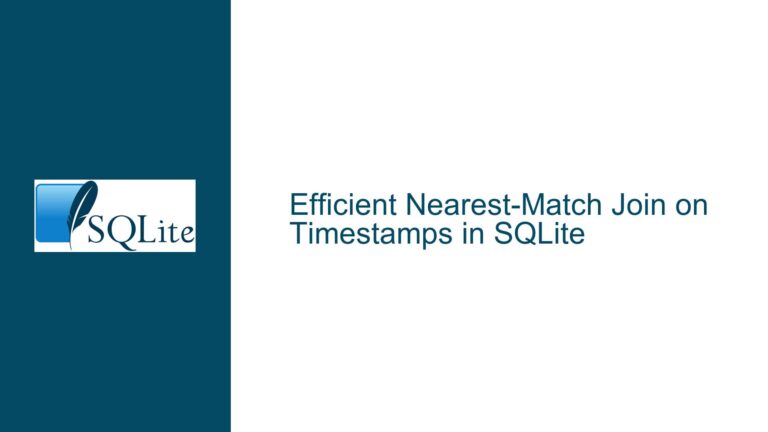SQLite UPDATE with 3-Way Join Fails on rowid in SET Clause
Understanding the UPDATE Statement with 3-Way Join and rowid in SQLite
The core issue revolves around an unexpected parse error in SQLite when attempting to use a rowid in the SET clause of an UPDATE statement that involves a 3-way join. Specifically, the error occurs when trying to update a column in table a with the rowid from table b in a query that joins table b with itself. The error message, "no such column: b1.rowid," suggests that SQLite’s parser is unable to resolve the rowid reference in the context of the 3-way join. This behavior is observed in SQLite versions 3.39.1 and later, while the same query executes successfully in version 3.37.2.
To understand the issue, let’s break down the schema and the queries involved. Table a is defined with two columns: foo (TEXT) and bar_id (TEXT). Table b contains a single column, bar (TEXT). The initial UPDATE query, which works as expected, updates bar_id in table a with the rowid from table b where a.foo matches b.bar. However, when a 3-way join is introduced—joining table b with itself on their rowid—the query fails with the aforementioned parse error.
The problem appears to be specific to the use of rowid in the SET clause of the UPDATE statement when a 3-way join is involved. Interestingly, if the SET clause is modified to use a regular column from table b (e.g., b1.bar), the query executes without issues. This suggests that the issue is not with the join itself but with how SQLite handles rowid references in the context of a 3-way join during an UPDATE operation.
Why rowid References Fail in 3-Way Joins During UPDATE
The root cause of the issue lies in how SQLite processes the UPDATE statement with a FROM clause involving multiple joins. When SQLite encounters an UPDATE statement with a FROM clause, it internally rewrites the query to include a subquery that represents the joined tables. In this case, the query:
UPDATE a
SET bar_id = b1.rowid
FROM b AS b1
JOIN b AS b2 ON b1.rowid = b2.rowid
WHERE a.foo = b2.bar;
is interpreted as:
UPDATE a
SET bar_id = b1.rowid
FROM (SELECT b.*, c.* FROM b JOIN c ON ...)
WHERE a.foo = b2.bar;
The critical issue here is that the rowid of table b is not included in the subquery generated by SQLite. The rowid is a special column in SQLite that uniquely identifies each row in a table, but it is not treated as a regular column in the context of subqueries or joins. As a result, when the parser attempts to resolve b1.rowid in the SET clause, it fails because the rowid is not part of the subquery’s result set.
This behavior is consistent with SQLite’s internal handling of rowid in complex queries. While rowid is accessible in simple queries and single-table operations, its visibility can be lost in more complex queries involving subqueries or multiple joins. This limitation is particularly evident in UPDATE statements with FROM clauses, where the parser’s ability to resolve rowid references is constrained by the structure of the generated subquery.
Resolving the rowid Issue in 3-Way Joins During UPDATE
To address this issue, there are several potential workarounds and solutions, depending on the specific requirements of the query and the version of SQLite being used. Below, we explore these options in detail.
1. Avoid Using rowid in the SET Clause
The simplest workaround is to avoid using rowid in the SET clause of the UPDATE statement. Instead, use a regular column from the joined table. For example, the following query works without issues:
UPDATE a
SET bar_id = b1.bar
FROM b AS b1
JOIN b AS b2 ON b1.rowid = b2.rowid
WHERE a.foo = b2.bar;
This approach is effective if the goal is to update bar_id with a value from a regular column in table b. However, it does not solve the problem if the rowid itself is required for the update.
2. Use a Subquery to Resolve rowid
Another approach is to use a subquery to explicitly resolve the rowid before performing the update. This can be done by first selecting the rowid in a subquery and then using the result in the UPDATE statement. For example:
WITH resolved_rowid AS (
SELECT b1.rowid AS resolved_rowid, b2.bar
FROM b AS b1
JOIN b AS b2 ON b1.rowid = b2.rowid
)
UPDATE a
SET bar_id = resolved_rowid.resolved_rowid
FROM resolved_rowid
WHERE a.foo = resolved_rowid.bar;
In this query, the WITH clause (Common Table Expression, or CTE) is used to create a temporary table resolved_rowid that contains the rowid of table b along with the bar column. The UPDATE statement then references this temporary table to set bar_id in table a. This approach ensures that the rowid is explicitly included in the result set used by the UPDATE statement, avoiding the parse error.
3. Upgrade to a Fixed Version of SQLite
As mentioned in the discussion, the issue has been identified as a bug and fixed in the SQLite source code. The fix is available in the latest versions of SQLite. Upgrading to a version that includes this fix (post-3.42.0) will resolve the issue without requiring any changes to the query. The fix ensures that rowid references are correctly resolved in the context of 3-way joins during UPDATE statements.
To upgrade SQLite, download the latest version from the official SQLite website (https://sqlite.org/download.html) and follow the installation instructions for your platform. After upgrading, the original query should execute without errors:
UPDATE a
SET bar_id = b1.rowid
FROM b AS b1
JOIN b AS b2 ON b1.rowid = b2.rowid
WHERE a.foo = b2.bar;
4. Use an Alternative Database for Complex Joins
If upgrading SQLite is not an option and the workarounds are not suitable for your use case, consider using an alternative database system that handles complex joins and rowid references more robustly. Lightweight databases like PostgreSQL or MySQL may offer better support for advanced query constructs, including UPDATE statements with multiple joins and rowid-like references (e.g., ctid in PostgreSQL).
For example, in PostgreSQL, the equivalent query would look like this:
UPDATE a
SET bar_id = b1.ctid
FROM b AS b1
JOIN b AS b2 ON b1.ctid = b2.ctid
WHERE a.foo = b2.bar;
Here, ctid is used instead of rowid to uniquely identify rows in PostgreSQL. This approach leverages PostgreSQL’s robust handling of complex joins and ctid references, ensuring that the query executes as expected.
5. Revisit Schema Design to Minimize rowid Dependencies
Finally, consider revisiting the schema design to minimize dependencies on rowid in complex queries. While rowid is a powerful feature in SQLite, relying on it for critical operations can lead to issues like the one described here. Instead, design your schema to use explicit primary keys or unique identifiers that are treated as regular columns. This approach ensures that all columns, including identifiers, are consistently accessible in all query contexts.
For example, modify table b to include an explicit primary key:
CREATE TABLE b (
id INTEGER PRIMARY KEY,
bar TEXT
);
Then, update the query to use id instead of rowid:
UPDATE a
SET bar_id = b1.id
FROM b AS b1
JOIN b AS b2 ON b1.id = b2.id
WHERE a.foo = b2.bar;
This approach eliminates the need to rely on rowid and ensures that the query is portable across different versions of SQLite and other database systems.
Conclusion
The issue of using rowid in the SET clause of an UPDATE statement with a 3-way join in SQLite highlights the importance of understanding how SQLite handles special columns and complex queries. By avoiding rowid in such contexts, using subqueries to resolve rowid, upgrading to a fixed version of SQLite, or revisiting schema design, you can work around this limitation and ensure that your queries execute as expected. For those requiring more robust handling of complex joins, exploring alternative database systems may also be a viable solution.






